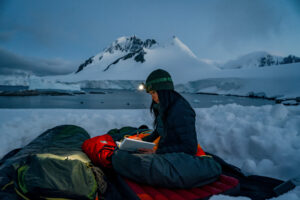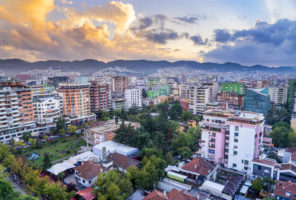Support Hidden Compass
Our articles are crafted by humans (not generative AI). Support Team Human with a contribution!
Lifeless Douglas firs draped over the crisped thicket, almost entirely blocking out the sun. A creek cut through the charred land, though I could not locate signs of life in this pocket of forest. One tree had burned so hot, it completely vaporized. All that remained was a white imprint on the earth, outlined like a body.
Hiking past scorched remains in Audubon Canyon Ranch’s Bouverie Preserve, more than a year after wildfire had devastated the hills of Sonoma County, California, it didn’t seem possible that this landscape would ever fully recover.
In 2017, the Tubbs and Nuns Fires had incinerated tens of thousands of acres in Napa and Sonoma counties, killing 25 people and countless animals, and swallowing nearly 7,000 structures. The media depicted the fires as anomalies, even though 53 years earlier, another fire had left a similar footprint across virtually the same landscape.
At Bouverie, not far from the hamlet of Glen Ellen, I carefully stepped into footprints left by the hiking boots of prescribed fire specialist Jared Childress, following him into the charred redwood grove. His deep voice reverberated through the canyon as he pointed out the effects of the wildfire having burned hot into the canopy on this side of the creek.
I hadn’t come here to witness the destruction, or for proof of the impacts of worsening wildfires. As a Californian, I already felt it viscerally — friends and neighbors racing from their homes; the rest of us shuttering inside sweltering houses for weeks in the hottest time of the year, rationing water and watching ash rain on our gardens. As a mother, I could barely sleep out of fear. My younger son’s asthma was worsening.
I had arrived in those burnt-out hills seeking a spark of hope — or, maybe, confirmation that I should get my family out now.
The force of wind and fire on parched land was putting humans in harm’s way. My humans.
But I wasn’t the only one searching for material to build from: Childress and I had joined a few members of the Federated Indians of Graton Rancheria, basket weavers who came to gather hazel leaves and shoots. Forged by the 2017 wildfires, these new growths had reached the right age to be used for weaving baskets.
That cool spring morning, Childress explained how more Western ecologists like him were starting to steward California’s forests in collaboration with Yurok tribal members and other Native people, who have embraced fire as a requisite tool to tend the land for at least 12,000 years.
He insisted we could — actually, that we must — change our relationship to fire.
“Yes, but … ” I started to say, my eyes focused on the scorched earth under my feet. I stopped myself short. What if we’re too late?
~~
Dawn seemed a mistake the morning the sky turned orange. My dog hesitated at the door, unable to decide if she should go out into the smoky stew. When she opted against it, I curled up on the couch and Googled, again, where on Earth we could be safe.
My nine-year-old son, Nikko, came bouncing up the stairs from his bedroom, rubbing the sleep out of his eyes as he grabbed his glasses.
“What’s happening?” He wrapped his fluffy robe around his Scooby Doo pj’s and then slid under the blanket with me. “Is this the apocalypse?”
I gathered him in my arms and inhaled his mango shampoo, wishing I had a better answer than the truth: We’d done this. The force of wind and fire on parched land was putting humans in harm’s way. My humans.
A year and a half after my hike in Glen Ellen, record-setting wildfires again raged in California. Only this time, they were in my backyard, gobbling up friends’ and colleagues’ houses just a few miles away. I’d shut the windows days ago, after thousands of lightning strikes, combined with an intense heat wave, began decimating the area in and around the Santa Cruz Mountains. These were the CZU Lightning Complex fires. Simultaneously, the August Complex fire engulfed more than a million acres farther north in the Golden State — California’s first “gigafire” — burning an area larger than the state of Rhode Island.
Nikko and his 13-year-old brother, Kai, proceeded to spend the morning boogie-boarding down the stairs, creating a ninja warrior course in the house, and playing indoor soccer, followed by an annoyingly loud game called Exploding Kittens. By lunch, I gave in and let them watch TV.
Three days in, all the local stores had sold out of air purifiers and portable air conditioners, and people were wearing gas masks to walk their dogs. Schools and state parks closed. Another superhero movie blared from my living room, but I didn’t see how anyone could save us.
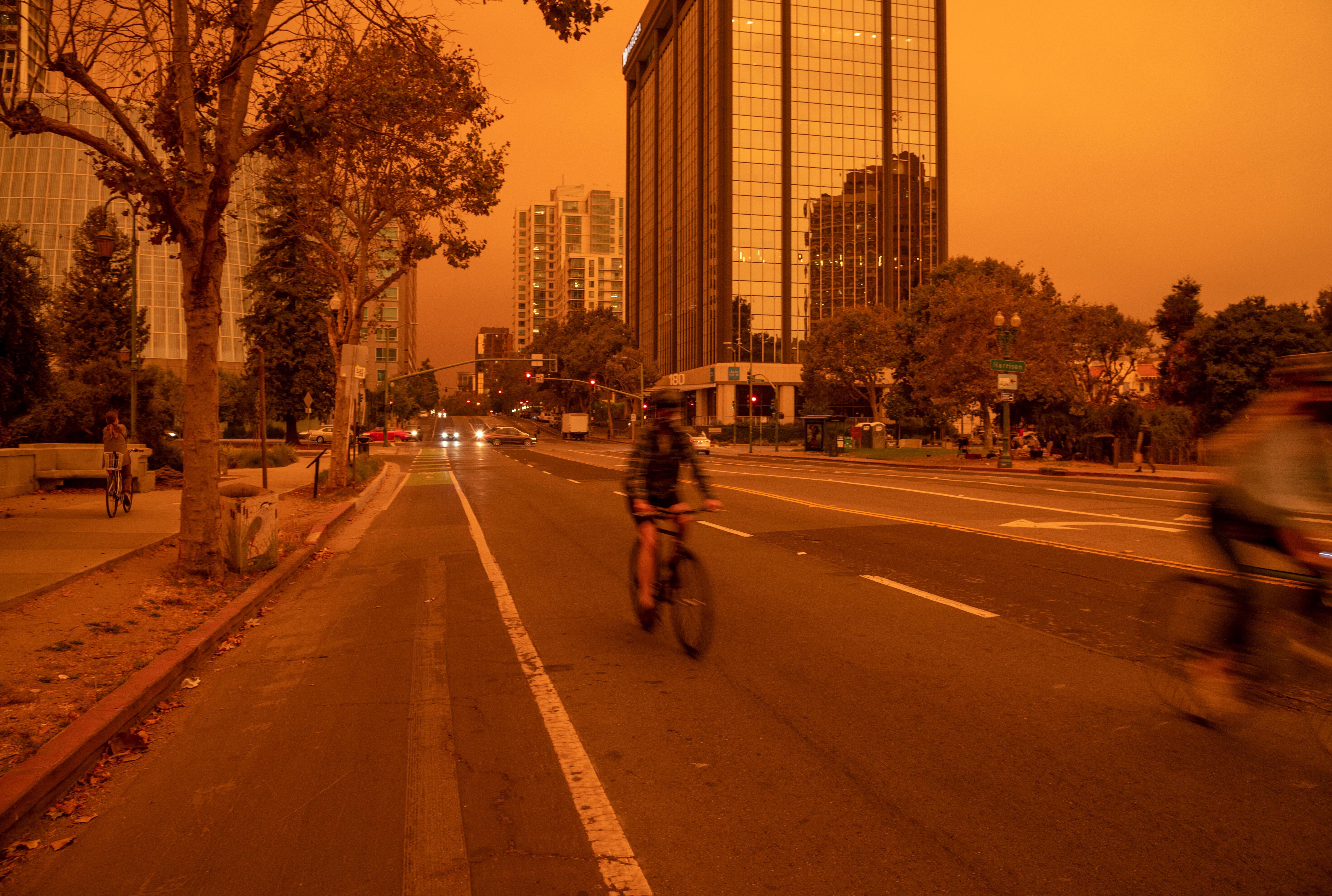
In August 2020, smoke from the CZU, LNU, and SCU Lightning Complex fires cloaked California’s Bay Area with surreal skies and hazardous air conditions. Photo: Roseangela Lima/Alamy.
~~
Back on my hike in Bouverie Preserve, Childress had suggested I attend a controlled burn. He thought the experience might help me learn to respect fire, rather than simply fear it. So, I called him up.
In the wake of the Tubbs and Nuns fires of 2017, Childress helped organize the Good Fire Alliance, connecting firefighters, landowners, and scientists — both Western and Indigenous — to address California’s wildfire problem. Seeking an alternative way of living with fire, the Good Fire Alliance convened these varied voices to help facilitate action: to get more “good,” or planned, fire on the ground. Practically speaking, that means providing permitting resources and discussing the differences, both subtle and significant, between the types of burns — including fuel sources, fire-management techniques, and objectives.
On the phone, I asked Childress if he knew about any prescribed burns led by local Indigenous groups that I could attend. He corrected my language, launching into a quick primer on the differences between the types of planned fires. Prescribed burns, he clarified, refer to an ecological prescription for a meticulous application of fire. Specific objectives might be to eliminate the twigs and underbrush that fuels wildfires, clear invasive plants, or stimulate a habitat for new growth. Other parts of the prescription include its precise environmental conditions — from exactly how hot to let the fire get to the specific fire breaks that will contain the blaze, whether roads, natural barriers such as creeks or bluffs, or strips of ground cleared down to bare dirt.
Planned fires led by Indigenous communities, on the other hand, are typically considered cultural burns. This spiritual practice of “low and slow” burning is done to tend the land, such as in other planned burns, but is also intended for cultural purposes — for instance, to encourage the growth of basketry materials, or to move elk and other animals integral to some Native traditions.
Suppressing fire snuffed out vital traditions — with cultural as well as ecological repercussions.
“Are there any cultural burns coming up?” I tried again on the phone with Childress, recalling the bureaucracy that went into going on the hike with the basket-weavers from the Graton Rancheria community. How before I even arrived, he had rattled off a series of don’ts levied from the tribal chair’s office — don’t directly quote any of the Indigenous community; don’t publish photos without the tribe’s permission.
“I’ll let you know,” Childress replied, quick to point out that cultural burning wasn’t his tradition to explain — nor to appropriate.
~~
The first time I met Childress, we had gathered under a spindly oak with the Federated Indians of Graton Rancheria basket weavers. He introduced the tall man with the quiet drawl as the master weaver, and the two women as his students. None of them met my eye. The taller woman pushed her dark hair off her shoulder and looked at Childress to welcome me, as if he were our translator.
He tried to bridge the awkwardness, saying, “You can talk to each other.” But the woman turned and walked into the charred forest. Taking my cue, I silently followed her into the woods.
As our group delved deeper into the landscape, though, we found our rhythm. Conversation opened up as we came upon bear grass and other signs of regeneration. I was told that the bark of oaks and redwoods protect the living tissue, called cambium, underneath. The outside can burn — its job is to act as a barrier that protects the life inside.
Arriving in the redwood grove, an elder pointed out how the ancient trees were sprouting in unusual places — when stimulated by fire that isn’t too intense, burnt redwoods and oaks have a chance to redirect their growth.
“And,” Childress said, cupping a delicate purplish sprout, “we get redwood orchids.”
We gathered around this rare blossom usually only brought forth by fire. The master basket-weaver bowed his head, offering a silent prayer of gratitude for the land.
At the hazel bushes, we were instructed to take just a few shoots from each — only what we need, and never so much as to deplete the source. The women divvied out the shears and seemed surprised when I put down my camera and asked to help.
A woodpecker knocked at a hollow tree. A jay chirped nearby.
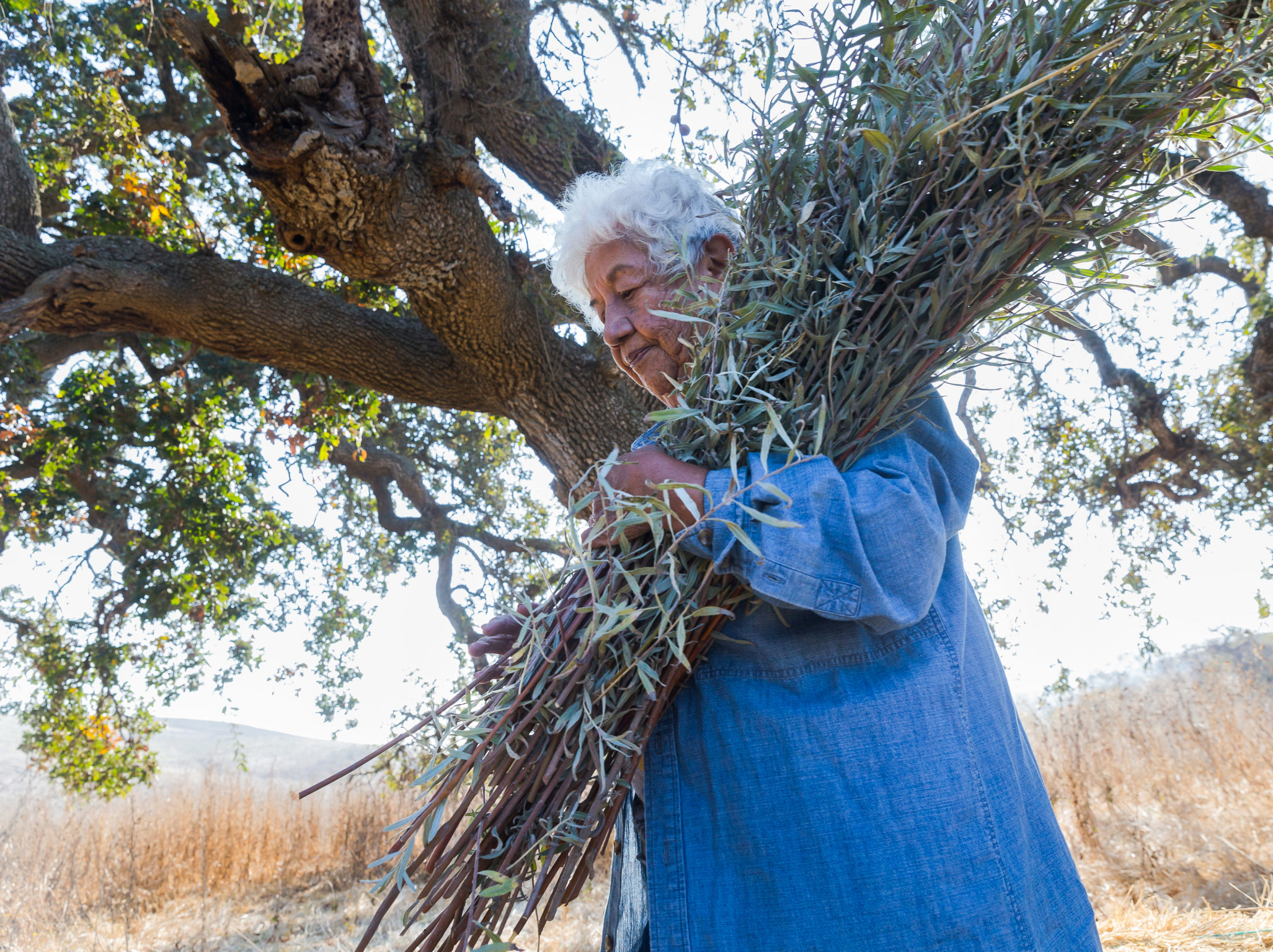
Joanne Campbell, a member of the Federated Indians of Graton Rancheria, collects willow shoots in Sonoma County to weave into baskets. Shoots like these sprout after fire. Photo: Peter Essick/Alamy.
For much of my life, fire had felt more like a nuisance than something to understand. Growing up in L.A.’s San Fernando Valley, there was the inconvenience of annual grassfires in the foothills that drew the rattlesnakes and rodents into our yard. The day firefighters evacuated our neighborhood and my mom told me to take my most cherished possessions, and I came running outside carrying a six-foot cardboard cutout of Michael Jackson. The night I stood on a ridge in Southern California with my dad, watching the mountains behind our house glow, watching him sweat with the fear of losing everything, while I worried about my new Vans tennis shoes. These glimmers were simply anecdotal.
Then I had children, and wildfires woke me up to the reality that we cannot draw an imaginary line that nature cannot cross. That day in the woods helped me start to realize that trying to draw a line of protection around my family wasn’t the answer either.
After all, fear was what had gotten us into this mess.
~~
Long before missionaries colonized the West, Native people here relied on cultural burning, from the Karuk and Yurok tribes of Northern California, to the North Fork Mono Tribe of the Sierra Nevada, and the Esselen Tribe near the Big Sur Coast. Burning away the overgrown brush surrounding an oak tree made it easier to access acorns, once a staple for some 75% of Native Californians, while also increasing nut production. These fires also helped move herds of game through the land and promoted healthy growth of the salad that grew in the understory — meaning there were not only fresh shoots of native grasses and berries for the people, but also for the animals they depended on.
When Spanish missionaries arrived, the colonists discovered open woodlands and idyllic meadows, which they mistook as natural, rather than the result of Indigenous cultivation. The outsiders brought a fear of fire. They criminalized burning, claiming concern for their property and livestock. In some cases, these practices were even punishable by death. Suppressing fire snuffed out vital traditions — with cultural as well as ecological repercussions.
Following a series of devastating forest fires across the United States, the Weeks Act of 1911 formalized a federal fear of fire, effectively making it arson to ignite a controlled burn on public forest lands. In the decades that followed, fighting fires became the U.S. Forest Service’s top priority. By the 1970s, after the post-war building boom drove up the demand for cheap lumber, logging in federal forests was near its peak. It resulted in the loss of fire-resistant trees and lessened the natural cooling effect in forests by thinning the tree canopy. Consequently, California’s forests were hotter, drier — and in trouble.
As scientists began sounding the alarm about the human impact of climate change, wildfires multiplied. A highly flammable mix of warmer climates, intensifying winds, and severe drought compounded the problem. The past two decades have seen 17 of the 20 largest wildfires in California history — six of which occurred in 2020 alone.
What if we’re too late?
While wildfires were becoming more common and more destructive, conservationists begged leaders to leave ecosystems alone in an attempt to replicate conditions in pristine environments. Meanwhile, foresters argued that we must manipulate landscapes to protect them. And ecologists were urging folks to manage the forest with the one thing they all feared — fire.
But few were listening to the people who had lived with this landscape for thousands of years — people who knew that suppressing fire was only going to make things worse.
~~
A few months had passed since fire turned our sky orange. My sons announced that another blaze was spreading near our Northern California house. This time, as scientists had predicted, it was not fire season.
Still determined to experience a cultural burn, I reached out to anyone I could think of — tribal leaders, fire ecologists, professors, and relevant organizations all along the California coast. No one offered an invite.
One morning, I drove through Bonny Doon, a community in the Santa Cruz Mountains, months after it had been devastated by the 2020 CZU Lightning Complex fires. Shells of burned-out homes and cars lined the road. The blackened trees and melted newspaper boxes and garbage bins still had not been hauled away. What didn’t burn was almost as surprising as what did. Evidence of children’s presences remained intact — a trampoline, a mosaic-tiled butterfly on a path through a garden with a name cemented in a child’s scrawl.
All those people without homes felt like a premonition — to say nothing of the rootless slugs and birds, deer and mountain lions.
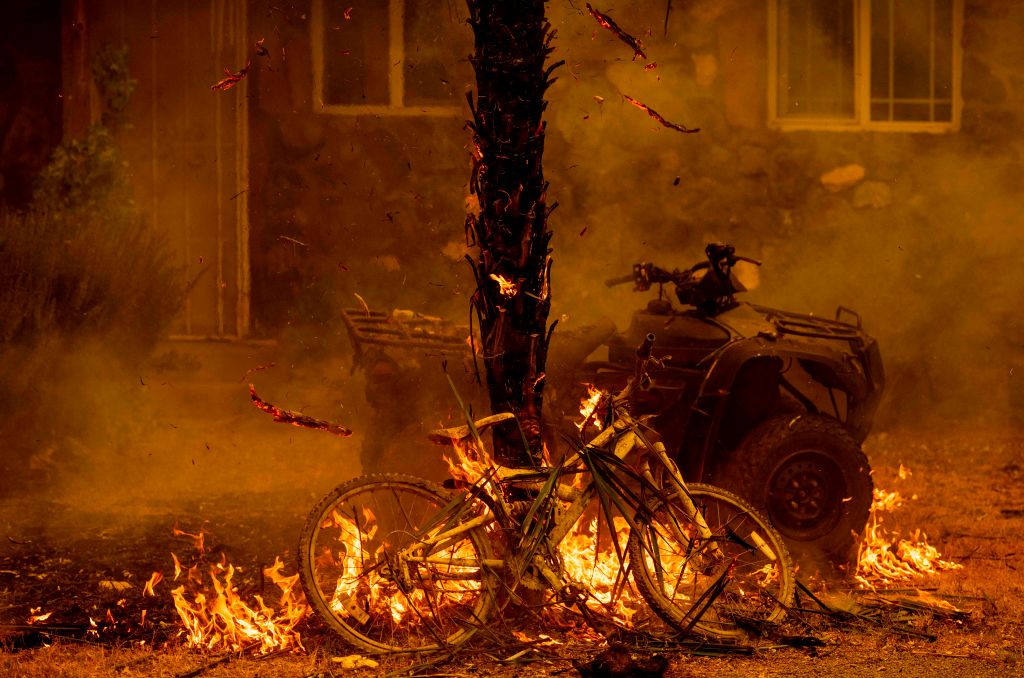
A bicycle and palm tree burn in Napa during the LNU Lightning Complex fire, part of a “lightning siege” that struck California in August 2020 and ignited hundreds of wildfires. Photo: Josh Edelson/AFP.
I thought back to a moment early in my parenting life. At the grocery store, Kai had picked up a bag of red grapes. I told him that grapes in our winter were not as good as ones in summer, but he begged me to buy them. As I tried to stand my ground, I realized what was wrong with my argument: By appealing to his taste buds, I was putting him at the center of his ecosystem.
Ultimately, I gave in to his meltdown but left the store knowing the issue was about more than expecting fruit on demand. My kids and I both needed guidance on how to have a reciprocal relationship with the planet.
At first, as I searched for techniques to “re-wild” my boys, I came across language more akin to the ways foresters, conservationists, and ecologists deal with our natural lands: I could guide my kids using prescriptive techniques (here’s how to do this) or I could control them (though anyone who has ever known a toddler knows what a joke that is).
None of the books taught me how to tend to my children’s benefit in equal measure as the land that sustains us. If I parented in that way — thinking about the benefit of each action on my sons but also on my larger community and the Earth itself — could I raise kids who didn’t think of the natural world as something to conquer?
~~
In the wee hours of morning, I motored up a windy backroad, then took a dirt road high into Esselen tribal lands. In the Santa Lucia Mountains above Big Sur, I was more than a hundred miles down the coast from Bonny Doon. After months of waiting, I had finally received the invite from Childress I’d been hoping for.
There, a man with an imposing presence called us into a circle and introduced himself as Tom Little Bear Nason, the tribal chairman of the Esselen Tribe of Monterey County. His face tanned and creased, he held a wooden talking stick topped with a wolf and wore a giant abalone necklace that opalesced in the rising sun.
Nason’s dark eyes passed around the circle of firefighters, scientists, and residents from as far as San Diego. He acknowledged his father and grandfather, calling out the names of the elders who taught him how to steward these rolling hills — home to a stand of massive heritage oaks, hundreds of years old — that we had gathered to help tend with fire. His words made me wonder: Could I become a future ancestor who would make my great grandkids proud?
Nason passed the stick to a woman in thick cargo pants, a bandana, and hiking boots. Head woman and elder of the Esselen Tribe, Cari Herthel faced the oak trees across the valley.
She tossed back her long hair and sang into the air, “What can I do to help and support you?” Then her voice deepened. A rumbling chant echoed off the mountains and then harmonized as it bounced back to where we stood. Her voice reached into the crevices of the rolling meadows — where oak branches bounced in the soft breeze, and buttercups reached up from the grasses. When her voice ceased, a cloud covered the winking sun. I knew I could never un-hear that sound.
Her chant propelled us through the overgrown coyote bush and grasses. We arrived at six dry piles of brush and branches, almost as tall as me. How were we supposed to contain a bonfire that large?
Fear was what had gotten us into this mess.
Childress explained to me that the overgrown area we’d just walked through was what stewards must avoid. It can take days of cutting and gathering to clear an area for a safe pile burn.
A retired “burn boss” from the Forest Service lit the first pile with a drip torch. With hand tools and pump sprayers, the Esselen members readied themselves to help with containment if needed. The blaze rose until the flames reached overhead. Fanning out, the firefighters stood guard over creeping burns that might escape the pile area. The burn boss motioned us closer.
The heat on my cheeks forced me backward until I stood next to Nason. Nearby, a couple deer munched around an oak, seemingly oblivious to the flames biting at the brush so close. When I pointed them out, Nason said, “When we burn, we leave some dead trees for birds to live in. And deer quickly get some fresh salad.”
Without fear in their way, they shared in the sustenance.
~~
A couple weeks later, I set off on a hike through Sonoma County’s Pepperwood Preserve, in the Mayacamas Mountains. Torched by wind-fueled firestorms twice in the last four years, the 3,200-acre preserve has emerged as a living laboratory at the forefront of fire resilience research.
My guide through the preserve’s oak groves and lupine-littered meadows was Clint McKay. An enrolled member of the Dry Creek Rancheria Band of Pomo and Wappo Indians, he’s the Indigenous education coordinator at Pepperwood, which sits on ancestral Wappo land.
McKay stopped to investigate the base of a black oak that looked to me like a tangle of weeds, explaining how the soaproot, Indian lettuce, and buttercup that now grew together in this shade were a byproduct of fire.
“The reset button has been pushed,” he whispered, explaining how these years of widespread wildfires could serve as an opportunity for Californians to start anew, if we choose to refresh our approach to fire.
As someone wanting to return to a way I never knew, I felt honored to be standing at the base of this tree integral to Wappo identity, listening to McKay’s words: “Our role is not to manage the forest, but rather to steward this land for the good of all beings: plant, animal, and human.”
Not just for my kids’, nor his grandchildren’s well-being. These semantics, he explained, are essential to our relationship with the Earth.
McKay rubbed his hands together. “We don’t look at this and say: ‘What’s in our best interest?’” he explained. “We say: ‘What’s in our natural world’s best interest — of these trees, these grasses, these animals, of the air, the water?’ We are a part of that, but our main focus is not us. The animals and the trees are our teachers. And we are not the boss out here.”
The scars from the pile burns surrounded us. The dry excess had been stripped from the understory, making way for a blanket of new bracken ferns and lilies.
In that storybook oak grove watching the moss sway, I thought about how these trees, like those throughout California — and like my kids — have survived multiple fires in their lives. Could adaptive strategies teach us how to coexist with our changing world?
“My people are all about seven generations,” McKay told me. “We say: ‘What are the decisions that I make today, and what impact will it have seven generations down the line?’ After the Tubbs Fire, I counted back in my own family tree, and my grandchildren are the seventh generation from the last time my people stewarded this land according to our cultural traditions. Sometimes if you say things long enough, it finally catches on.”
~~
I’ve stopped Googling places I can go to be safe. When my family recently moved to a new house, Nikko and I purchased fruit trees for our front yard.
“I can’t wait to eat the peaches,” he said, urging his shovel into the clay dirt.
“We don’t look at this and say: ‘What’s in our best interest?’… We say: ‘What’s in our natural world’s best interest — of these trees, these grasses, these animals, of the air, the water?’”
I inhaled the foggy California air and thought about McKay’s seven generations. “Baby, we’re not just planting these trees for us. It’s really for whoever, animal or human, might occupy this space next.”
“Yeah, but hopefully, we’ll get enough next summer to make a cobbler, right?” Nikko made me stop digging to give a potato bug time to climb out of the hole.
“Hopefully,” I answered once the bug was safely on the grass. Then I tossed a cup of compost into the hole — and a bit of gratitude for good measure.
~~
On my first hike with Childress and the basket weavers back in 2019, the incinerated Douglas firs were only part of the landscape — the part that had been left untended before the wildfires. The rest of the story is what hooked me.
Childress had tended other parts of the land using prescribed burns, and he excitedly pointed out the differences along the creek. A blanket of poppies and lupine dotted the native grasses; birds and bumblebees flitted between trees; the stewarded oaks and rosy madrones sprouted shiny green leaves, showing off how gracefully they’d evolved to survive wildfire.
As I wrapped the hazel I’d gathered in willow, the master weaver showed me how to knot the shoot. The best materials, he told me, arrive after fires, when the new willow and hazel shoots are pliant enough to manipulate.
“Like us,” I said with a wink, thinking how one of the biggest lessons I’ve learned as a mom is adaptivity: first in my body and then my home, in my daily routine and identity. All those sacrifices have given root to rewards beyond my imagination.
We can’t suppress fire any more than we can extinguish our fears. Building hope, for us and for the generations that follow, comes from facing both challenges in tandem. Like fire coaxing out new growth, fear can propel us forward, if we let it.
Michele Bigley
Above all her accolades as a writer, activist, and teacher, Michele Bigley is most proud of her identity as a mother. Her two sons, Kai and Nikko, remind her every day that making the world a better place is the only work worth pursuing.

